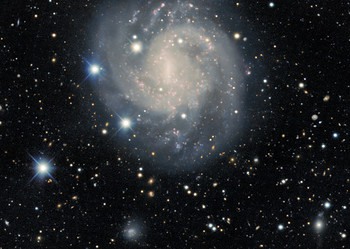
Shaking up long-held ideas about galaxy creation in the early cosmos, astronomers have found one of the most far-off rotating disc galaxies yet seen. Dubbed REBELS-25, the galaxy appears as it did when the universe was just 700 million years old—about five percent of its present age. Its spiral structure challenges theories of how galaxies develop and grow. The rotational structure of REBELS-25 contrasts sharply with the usually chaotic and disorganized galaxies seen from this early era.
Based on high-resolution data gathered by the Atacama Large Millimeter/submillimeter Array (ALMA) in Chile’s Atacama Desert, the study was carried out by an international team of researchers. Because of fast star development and frequent collisions with neighbors, galaxies from the beginning of the universe are typically clumped, untidy, and turbulent. Unlike the tranquil, ordered discs we mostly observe in galaxies now, these conditions produce somewhat erratic forms.
“According to our understanding of galaxy formation, we expect most early galaxies to be small and messy looking,” says Jacqueline Hodge, an astronomer at Leiden University, the Netherlands, and co-author of the study.
Originally found in earlier ALMA data, REBELS-25’s actual structure was verified only in follow-up observations at a greater resolution.
“ALMA is the only telescope in existence with the sensitivity and resolution to achieve this,” says Renske Smit, a researcher at Liverpool John Moores University and a co-author of the study.
The more detailed images revealed a galaxy with elements suggesting additional evolution beyond simple rotation, including a core bar-like structure and evidence of spiral arms like our own home galaxy.
“Seeing a galaxy with such similarities to our own Milky Way, that is strongly rotation-dominated, challenges our understanding of how quickly galaxies in the early Universe evolve into the orderly galaxies of today’s cosmos,” says Lucie Rowland, a doctoral student at Leiden University and first author of the study.
The researchers also discovered that REBELS-25 is remarkably large for its age, driven in great part by gas-driven rapid rates of star creation. Still, the galaxy’s spin seems constant, suggesting it has already found a stable form. One of the biggest known galaxies from this early epoch, the team believes the dynamical mass of the galaxy is more than 100 billion times that of the Sun.
Although identifying REBELS-25 offers fresh understanding, it also begs significant issues regarding galaxy development. How did a galaxy acquire such a well-organized framework rapidly following the Big Bang? Rowland says future studies should provide more hints regarding the mechanisms allowing REBELS-25 to develop and change so quickly.
“Finding further evidence of more evolved structures would be an exciting discovery, as it would be the most distant galaxy with such structures observed to date.”
The work was accepted for publication in the Monthly Notices of the Royal Astronomical Society.






